This is a blog about images and stories, technology and craft. For the sake of Yaakov as well as others I will risk a distance from the normal sparseness of words and do my best to write a little about the symbolism in Jacob Wrestling With God.
When I make a painting, there is always a tension between intent and intuition. In the painting of Jacob, there is meaning that I intended to place there and there is meaning that emerges as I work, often pointed out by an outside observer. Both are placed there in faith, and both are discovered again in faith. I receive requests to reproduce the image of Jacob Wrestling with God regularly. Whatever other arrangements are made, I always beg the insight of the requestor, because I want to know what has been placed in my work by God, which is hidden to me, but perhaps not to them. One gracious responder was Robbie Pruitt, who actually wrote a review of the work, which can be read on his blog.
Violence and intimacy. The violence and intimacy of this wrestling match. What did it sound like, how did it smell, the sweat of God and Jacob mingled in the dust? Those who are willing to pursue God and his blessing with such force receive honor from me. I don’t know what Jacob was thinking. But I know I wish I had the guts to engage my God with such an intertwined closeness. I despise the distance of religion. I use that distance to keep myself “safe” in this life, but at what cost. Even if I am annihilated, at least I may have a glimpse of His glory before I am withered back to dust. I want to know who He made me to be, why I am here, what my name is, even if I have to wrestle with one who could wither me with a glance. This story is a profound mystery to me, but I love it because God made himself vulnerable for the sake of this man whom He loved. I don’t get that, but it makes me love Him even more. I would rather be undone by the _ord than sit here safe and placid before my computer.
Visual Symbolism:
The banner has been present in my work for decades. I won’t go into all it’s permutations, but in this case I think of it as God’s declaration and promise over Jacob. It contains mysteries and words spoken in the Spirit from the beginning of creation until the end of days. They are blank, because, who am I to presume.
The curtains speak both of intimacy and story, as they are drawn back to reveal a glimpse of the man Jacob’s story and intimacy with his God. The curtains as well always recall to me the curtain that separated the most holy place of the temple, where the presence of God would come. Then when it was torn apart when Jesus was crucified; another time of violence and intimacy, when God made Himself vulnerable for those He loved.
The hands reveal the glory.
There is something important to me concerning of the knee of Jacob near the stone in the corner, but I do not understand what.
The nudity of Jacob, perhaps goes without saying. But nothing is hidden from God.
There used to be a couple of ladders toppling about in the struggle, recalling a previous encounter Jacob had, but I decided to paint over them.
There is more in this story, because it is God’s. But this is what I have painted. Please, be welcome to offer your insights, and I thank those of you who have risked writing comments and emails.
Jack
(Below is a progression of the painting)
Below is the drawing that came first, and a linocut based on the painting.

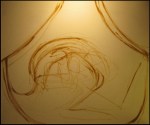
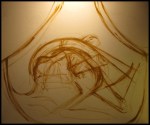
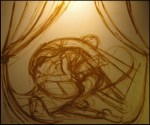

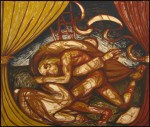
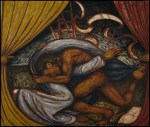

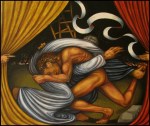
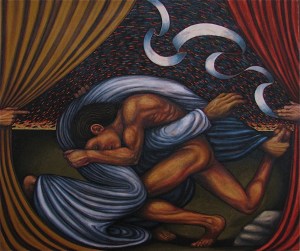


Well done, friend. Thank you for the insight.
-Mikey
Also, I might add, what a visual gift to see all of the different versions of this theme at the same time. It would be great to see them all in a show, all on one wall together.
Jack,
Thanks for the mention in your article!
I posted the following on my facebook wall today, hope you don’t mind:
“An art review I did a while back on Jacob Wrestling With God, by Jack Baumgartner, got mentioned and elaborated on in an article by Jack on his web site, The School of the Transfer of Energy. If you like good art and theology, check it out. Jack does an amazing job and is a great artist and craftsman! https://theschoolofthetransferofenergy.com/2011/11/14/symbolism-of-jacob/”
I appreciated the ladders in the original work . . . to me they symbolized the cross and the Trinity and they recalled Jacob’s dream . . .the painting is amazing as well, and I appreciate it on a whole new level . . .and love the colors!
You said: “There is something important to me concerning of the knee of Jacob near the stone in the corner, but I do not understand what.” I have some insight on this, I think, and will run it by you later when I have some more time . . . .
Thanks for your artwork and your heart brother!
Keep at it to the _ord’s Glory!
Robbie
Robbie, I look forward to your insight on the stone and the knee.
Jack
Jack,
I just sent you an e-mail today. . . would like to post an art review on my blog of this painting, Jacob Wrestling With God. I would also like to use the image to teach with if that would be alright. . .
Here is what I have on “Stone and Knee:”
Stone and Knee: Theological Reflections
By Robbie Pruitt © December 17, 2011
Are we stumbling on stone, or standing on stone? Are we knees knocking, or bowing with bended knee?
Stone
Are we stumbling on stone, or standing on stone?
“Then Jacob rose early in the morning, and took the stone that he had put at his head, set it up as a pillar, and poured oil on top of it.” – Genesis 28:18
“Then Samuel took a stone and set it up between Mizpah and Shen, and called its name Ebenezer, saying, “Thus far the Lord has helped us.” – 1 Samuel 7:12
“Therefore thus says the Lord God: “Behold, I lay in Zion a stone for a foundation, A tried stone, a precious cornerstone, a sure foundation; Whoever believes will not act hastily.” – Isaiah 28:16
One of the first places in scripture where we see the word stone referenced is in an act of worship with Jacob (see Genesis 28:10-22). Stones are often used in scripture in worship, as memorials, or are built into altars for worship (see Joshua 4:1-10). Stones are referenced many different times in scripture and have great significance.
In Psalm 118:22-23 the psalmist says, “The stone which the builders rejected has become the chief cornerstone. This was the Lord’s doing; It is marvelous in our eyes.” This Psalm clearly echoes the prophesy of Isaiah, “Therefore thus says the Lord God: “Behold, I lay in Zion a stone for a foundation, A tried stone, a precious cornerstone, a sure foundation; Whoever believes will not act hastily (Isaiah 28:16).”
In the New Testament, Peter speaks about this Old Testament passage as well when he references it in 1 Peter 2:4-8. Peter says that we should come to Jesus, the cornerstone and be ourselves living stones. He says, “Coming to Him as to a living stone, rejected indeed by men, but chosen by God and precious, you also, as living stones, are being built up a spiritual house, a holy priesthood, to offer up spiritual sacrifices acceptable to God through Jesus Christ (1 Peter 2:4-5).”
Paul also references the rejected Cornerstone in Romans 9:32 when he speaks of Israel not attaining God’s salvation that the Gentiles received by faith in Jesus. Paul says, “Because they did not seek it by faith, but as it were, by the works of the law. For they stumbled at that stumbling stone.” The Jews were stumbling over Jesus and were seeking righteousness and salvation through the law. Meanwhile, the Gentiles were becoming children of God through their faith in Jesus. As we look at this passage, we can hear echoes of what John the Baptist said to the Pharisees and Sadducees about stones in Matthew 3:9: “Do not think to say to yourselves, ‘We have Abraham as our father.’ For I say to you that God is able to raise up children to Abraham from these stones.”
Knee
Are we knees knocking, or bowing with bended knee?
“All hands shall be feeble, and all knees shall be weak as water.” – Ezekiel 7:17
“Strengthen the weak hands, and make firm the feeble knees. Say to those who are fearful-hearted, ‘Be strong, do not fear! Behold, your God will come with vengeance, with the recompense of God; He will come and save you.’” – Isaiah 35:3-4
In the Old Testament, the word knee or the concept of kneeling, or “knocking knees” is equated with fear or weakness. Even today, the idea of “knocking at the knees” seen as an image or word picture of fear. The New Bible Dictionary emphasizes that people in Old Testament times understood references to knees as “concrete imagery” that “expresses weakness or fear as ‘feeble knees’ (see Job 4:4, Isaiah 35:3, Nahum 2:10, and Daniel 5:6).”
In the New Testament, knees are referenced in connection with bowing in most cases. According to The New Bible Dictionary, “this action may indicate a sign of respect, or subjection (see Romans 11:4 and 14:11).” Simply put, bending your knee is a picture of adoration or worship. It is also a posture of prayer and humility (see Luke 22:41, 1 Kings 8:54, and 1 Kings 18:42).
One of the more famously recognized verses of New Testament scriptures about kneeling is in reference to Jesus’ Lordship. Paul writes to the Philippians, quoting Isaiah 45:23, “That at the name of Jesus every knee should bow, of those in heaven, and of those on earth, and of those under the earth, and that every tongue should confess that Jesus Christ is Lord, to the glory of God the Father (Philippians 2:10-11).”
Are we stumbling on stone, or standing on stone? Are we knees knocking, or bowing with bended knee?
Works Cited
The New King James Version. Nashville : Thomas Nelson, 1982, S. Php 2:10-11
Wood, D. R. W.: New Bible Dictionary. InterVarsity Press, 1996, c1982, c1962, S. 657
THanks Jack. I enjoyed that!
yaakov….
I really liked your blog post. Really Great.
http://www.uumctulsa.org/blog/?p=402
Hey Jack–thanks for the use of the painting–I reflected on your work in my own blog, posted above. Hope your evening on the plains is as pleasant as ours over here in Tulsa.
Jack! What a beautiful rendition of a classic struggle with our God. The beauty of this piece, for me, is its timelessness; each of us are able to insert ourselves where Jacob is. I admire the sensuality of the piece; our God has a deep, intimate love for each of us and this piece reaffirms that! Thank you so much.
I have a question- when I was looking at the piece, my eyes, in art, look for consistency and incongruence. It is clear that the hands holding back the veil are dissimilar. Was there a purpose to making the hand on the left point its finger and the hand on the right have all fingers but the pointer extended? Curious!
Honored to view this piece and thankful for your giftedness.
Blessing and grace to you,
Shannon
Thank you, Shannon for your generous words. I am grateful as well for your naming the “sensuality” of the painting. I think it is an important nuance of the intimacy in the story and the picture that has almost been hidden from me. I wish I had a good answer for the hands. I make many intuitive decisions as I work. The hands being dissimilar and asymmetric yet balanced, in that the extended finger of one is the withdrawn finger of the other, was a very conscious but intuitive decision. The hand on the right is an important gesture, I am sure in my spirit that it is, I just don’t know what it is.
Thank you again for your comment.
Ahhmmm… Hey Jonah,
What a beautiful Artist you are in so many ways. High 5 as AN ARTIST, there are many but few as good as you. Trust me.
W.o.w!
I am a Christian and I have a website. Now if you truly knew me, you would love me. Cause I am really cool… but it is in humiliation and humility that I say this. When we speak to each other, let us be real from the outset. So I love your work. I am not related to any Church, Sect, Movement, Thingy… religions etc… AT ALL. I am on my own and HIM (or course) with some friends.
Question to you. May I use some of your talent for free with your permission on my Christian Website: http://www.OkChrist.com (I am poor… and zero backup… but I am true).
Let me know, dear Sir.
Either way, carry on… YOU R an amazing Artist… and as a Film Producer and a Music Producer, I always said:
– “You (Artist), you HAVE NO RIGHT to limit your talent to yourselves. It was given to you. YOU must give it back… in thankfulness to the Godhead. Any decision you make… make sure it is to do what you love, thus giving back to the world (for their longing needs)”. Do what you love…
#philippepaquette
Finely done. They’re beautiful. A request: I’m editing my syllabus for my freshman course in Old Testament Survey. May I use one of your “Jacob Wresting with God” images as the cover art? What are your terms for such permissions?
Here is a link to my poem on Jakob’s Jabbok journey, inspired by a visit to the Jabbok, January 6, 2014.
https://www.facebook.com/editnote.php?draft¬e_id=10152111020691422&id=765464399
Hi Jack, there is so much to this struggle, we are told in 1 Corinthians 13:9 “For we know in part and we prophesy in part..” and therefore our struggle is to Stop getting in the Way of the TRUTH…Jesus sometimes has to disable or handicap us, for our own safety and security. Thank you.
PS ..I have a music youtube channel with orginal songs SKILLESCA Productions that I have just started, I was seeking permission to use this as part of my imagery of JACOB and God wrestling in some of the songs and instrumentals I have written.
KInd regards
Saul Illesca
Hi Jack, I just saw this painting and your commentary above for the first time as part of a Bible study. What occurs to me is that God is holding Jacob’s leg and knee from being crushed on the rock. The image evokes for me an experience from my past. My daughter is/was autistic, and when upset as a child would be “all out” screaming, flailing, scratching her own face etc. Many times, I held her in a kind of full body hug, standing or sitting behind her, my legs wrapped around her, arms around her, holding her wrists to her chest to keep her from hurting herself until she calmed. This image of Jacob gives me a perceptual shift of the Jacob story – God is not wrestling or “fighting back”, he is holding Jacob safe until Jacob is finished struggling against God. This is a beautiful image, and a deep memory for me, thank you. -Betsy
Betsy,
Thank you so much for your story and insight into this story- it is so valuable to me. Peace be with you!
Jack